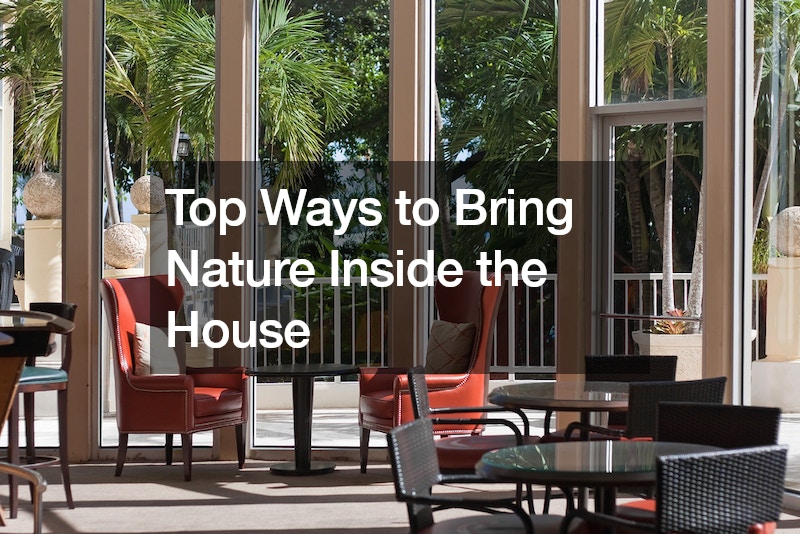Incorporating elements of nature into interior spaces can enhance the overall ambiance of a home, fostering a sense of tranquility and connection with the outdoors. From introducing natural light to integrating greenery, there are various ways to bring the beauty of nature inside the house. Here are some top methods to achieve this:
Install Skylights or Rooflights: One of the most effective ways to infuse natural light into interior spaces is by installing skylights or rooflights. These architectural features allow sunlight to penetrate deep into the home, illuminating rooms and creating a bright and airy atmosphere.
Skylights can be strategically placed to maximize sunlight exposure and provide stunning views of the sky, enhancing the aesthetic appeal of any living space. Additionally, rooflights can be equipped with features like remote operation and laminated glass for safety and convenience.
Introduce Indoor Plants: Incorporating indoor plants is an excellent way to bring nature indoors while also improving air quality and adding visual interest to a room. Plants not only contribute to a more vibrant and lively ambiance but also have a calming effect on occupants. Consider incorporating a variety of houseplants, such as ferns, succulents, and peace lilies, to create a diverse and inviting indoor garden. Place plants near windows or skylights to ensure they receive adequate sunlight for healthy growth.
Create Natural Vignettes: Design natural vignettes throughout the home by incorporating elements like driftwood, stones, seashells, and other natural materials. These organic accents can add texture, warmth, and visual appeal to interior spaces, evoking a sense of serenity and connection to the outdoors. Arrange natural objects on shelves, tables, or countertops to create visually captivating displays that reflect the beauty of the natural world.
Utilize Natural Materials: Choose furniture, flooring, and decor made from natural materials like wood, stone, bamboo, rattan, and jute to infuse a sense of warmth and authenticity into interior spaces. Opting for natural materials not only adds visual interest but also creates a harmonious and inviting environment. Incorporate wooden furniture, stone countertops, and woven textiles to introduce texture and earthy tones that complement the surrounding decor.
Embrace Biophilic Design: Biophilic design is a concept that seeks to connect people with nature by incorporating natural elements into the built environment. Embrace biophilic principles by integrating features like water features, living walls, and natural light sources into interior spaces. Design elements inspired by nature, such as organic shapes, patterns, and colors, can evoke feelings of calmness and well-being while promoting productivity and creativity.
Maximize Views of the Outdoors: Take advantage of picturesque views of the outdoors by strategically positioning furniture and creating cozy seating areas near windows or glass doors. Maximize natural light and outdoor views by keeping window treatments minimal or opting for sheer curtains that allow sunlight to filter into the room. Opening up interior spaces to the outdoors can create a seamless transition between indoor and outdoor living areas, blurring the boundaries between the two.
Water Features: Incorporating water features such as indoor fountains, ponds, or even small tabletop water gardens can introduce a sense of tranquility and serenity into interior spaces. The soothing sound of flowing water can help mask background noise and promote relaxation, while the sight of water can evoke feelings of calmness and refreshment. Water features can be strategically placed in entryways, living rooms, or bedrooms to create a focal point and enhance the overall ambiance of the space.
Nature-Inspired Artwork: Incorporating artwork inspired by nature can bring the beauty of the outdoors into interior spaces and serve as a focal point or conversation starter. Consider hanging paintings, photographs, or prints depicting landscapes, flora, or fauna to evoke a sense of connection with the natural world. Nature-inspired artwork can add visual interest, color, and texture to walls, creating a dynamic and inviting atmosphere.
Natural Scents: Enhance the sensory experience of a space by incorporating natural scents such as essential oils, dried herbs, or fragrant flowers. Consider using aromatherapy diffusers, sachets, or potpourri to infuse rooms with refreshing and invigorating scents like lavender, eucalyptus, or citrus. Natural scents can evoke memories, improve mood, and promote relaxation, creating a more inviting and rejuvenating living environment.
Outdoor Living Spaces: Extend the connection to nature beyond the confines of the home by creating outdoor living spaces such as patios, decks, or gardens. Outdoor areas can serve as an extension of interior living spaces, providing opportunities for dining, entertaining, or simply relaxing amidst nature. Incorporate elements like outdoor furniture, planters, and lighting to enhance the functionality and aesthetics of outdoor living spaces, allowing homeowners to fully enjoy the beauty of the natural world right outside their door.
In conclusion, incorporating elements of nature into interior design can have a transformative effect on the look and feel of a home. Homeowners can create inviting and harmonious living spaces that celebrate the beauty of the natural world. Whether it’s infusing rooms with natural light, incorporating organic textures, or bringing the outdoors in through greenery and decor, there are countless ways to create a nature-inspired home that promotes well-being and relaxation.
.


